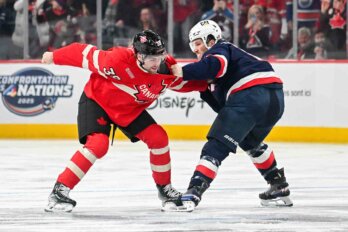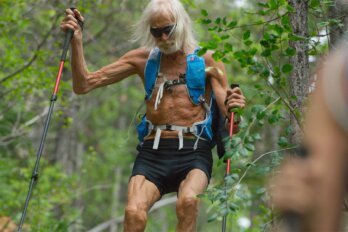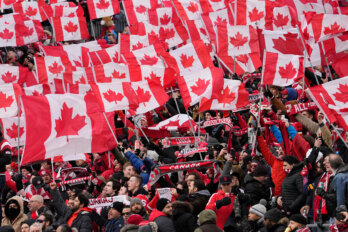Memphis Dick catches the ball at the top of the three-point circle in a triple-threat position. She can either shoot, pass, or use her speed and superb dribbling skills to drive to the hoop. The sixteen-year-old squares up against her defender, fakes a shot, then drives past her with ease. As the defence collapses around the five-foot-six point guard, Dick bounces the ball to a wide open teammate under the basket who then lays it up for an easy score.
This puts the Hesquiaht Storm, a team of teenage girls from the Nuu-chah-nulth people of Vancouver Island, up 4–0 over the Greenville Timberwolves to start the game. Dick runs back on defence, her shoulder-length hair pulled back in braids. Sweat drips down her forehead as she guards Greenville’s ball handler with relentless aggression for four ten-minute quarters.
It’s March, and I’m watching Dick and her teammates in the semifinals of the 2018 Junior All Native Basketball Tournament. I’m doing the play-by-play broadcast of the game on Canada’s First Nations Radio Network—a gig I’ve had for the past six years—and have a bird’s-eye view of Dick’s wizardry from the top of a packed gymnasium at North Vancouver’s Capilano University. To my left is a sea of Greenville fans dressed in green. To my right, a sea of Hesquiaht fans dressed in reddish-brown. I can’t tell you who’s louder. Fans bang drums in a thunderous rhythm when their team scores. The scene resembles a modern potlatch as much as it does a sporting event.
There are eighty-three teams this year and more than 1,000 youth representing First Nations from throughout British Columbia.
As with every tournament, there is tribal pride on the line and a legacy dating back more than fifty years that represents much more than a sport to these communities.
Though the sport as we know it was created by Canadian educator James Naismith in 1891, basketball hasn’t always been embedded in BC First Nations culture. But for Indigenous youth today, it is just as much a part of their day-to-day lives as hunting and fishing were for their ancestors. “For all of us, basketball really became sacred,” says Tyson Touchie, a former player who joined the Storm as an assistant coach in 2017. (He still plays competitively on weekends.) “It’s entrenched in our culture.”
Jocelyn Dick sits in the bleachers to my right, beaming with pride. Her daughter’s speed and defensive tenacity is tough to match by girls her age. Memphis’s poise on the court reminds of me of players in their twenties and thirties whom I’ve seen lead teams to championships at the adult All Native Basketball Tournament every February in Prince Rupert in northwestern BC. I wouldn’t be surprised to watch her dominate that tournament—which originated in 1947, when it was the Northern British Columbia Coast Championship Tournament, and eventually birthed the Junior All Native—as her skills advance in the years to come. But Memphis’s playing style is as particular as it is skilful—her mother tells me it sends chills down her spine.
“She really reminds me of my late father, J.B. Dick. I have pictures where you can see a lot of similarities [in body posture],” Jocelyn explains following the Storm’s 48–38 victory over the Timberwolves. “I see my dad in the way that Memphis dribbles and her intensity on the court.” The next day, Memphis’s team would head for the championship game, the same stage that J.B. Dick starred in for so many years.
Many other Nuu-chah-nulth people have remarked on the uncanniness of Memphis’s game. It’s like she’s carrying the spirit of her grandfather, they tell me. He, too, was a point guard, essentially the quarterback of basketball, the leader on the court. Memphis has heard the comparisons ever since she started playing basketball, at age eleven. She tells me that’s why she displays the number fourteen on her Hesquiaht jersey—the same number J.B. wore. “People tell me he was legendary on the island,” she says with a dimpled smile after the semifinals game. “It makes me feel really good and proud of myself.”
The strange thing is, Memphis never met her grandfather. J.B. passed away from cancer eight years before his granddaughter was born. Yet Memphis somehow emulates the style of an ancestor she never saw play. And that’s what makes the All Native as a whole so special: it’s a reminder of who came before.
A mural of a yellow sand beach hugging the shoreline of the ocean’s high tide adorns the outside walls of Maht Mahs, the gymnasium on the Tseshaht First Nation reserve near the Vancouver Island town of Port Alberni. The gym is spoken of almost like a sanctuary by many Nuu-chah-nulth people. It carries the same weight as a historic village site along the Somass River, where people from Tseshaht traditionally fished for salmon. Jocelyn Dick was practically raised in Maht Mahs. She grew up watching her father run drills and compete in tournaments, often against neighbouring Nuu-chah-nulth communities, in the 1980s.
“They would go hard and duel it out on the court. And, off the court, they respected each other madly,” she says. “Team rivalries like you’ve never seen before, which almost funnelled into family rivalries. But there was still so much respect.” Tseshaht is one of fifteen Nuu-chah-nulth communities with traditional territory and waters spanning much of the west coast of Vancouver Island. Translated to English, Nuu-chah-nulth means “All along the mountains and sea.”
The nation has a long pre-colonial history of social interdependence as well as intertribal war. In the mid-nineteenth century, a devastating war between the Mowachaht and Muchalaht Inlet groups left the Muchalaht with a near handful of people left. Over the next century, the two groups became closer through intermarriages, and they eventually united in 1951, becoming members of the Nuu-chah-nulth Tribal Council. This complicated history of the Nuu-chah-nulth nations, containing a blend of rivalry and respect, was resurrected on the basketball court during J.B.’s time. Dick is remembered as one of the most fierce competitors by those who saw him play and played against him.
He laced up his sneakers until his dying days; not even cancer slowed him down. His wife, Joan Dick, recalled that J.B. “did six weeks of chemo and he was losing his hair and stuff. And it was only a week after he finished, he put on a kerchief and he went out there and played ball.” He coached many of the youth in Tseshaht. His death left a void, both on and off the court—one that spectators and relatives say has been eased by the grace of his granddaughter.
“This is intergenerational now,” says Wawmeesh Hamilton, who is from the Hupačasath First Nation, a neighbouring Nuu-chah-nulth community to Tseshaht. “There’s grandparents who played in the predecessor to the Junior All Native. There’s parents who played in the Junior All Native. You got kids and grandkids now playing in this game. Wrap that up with tribal pride? Deep, deep meaning.” Hamilton is at this year’s tournament to watch his daughter play. He has also covered the Junior All Native as a fellow journalist for nearly fourteen years and grew up watching the J.B. Dick generation compete at Maht Mahs and the Port Alberni Athletic Hall in the 1970s.
“The first predecessors of the Junior All Native was when one residential school played against the other,” he says. “And then these guys would go home after they left the school, and they would keep playing. Before you know it, reserves are playing against each other.”
I learned from Jocelyn that J.B. Dick was a residential-school survivor. The residential-school system caused a gap in the transfer of cultural knowledge from one generation to the next: Indigenous children were cut off from the wisdom of their ancestors and shamed for practising their culture. For many intergenerational survivors of residential school, basketball became a cultural substitute. “We had basketball more than we had our culture. It was more readily available,” Touchie, the Storm’s assistant coach, explains.
We talk in the hallway outside the gymnasium while his Storm team is in the locker room getting ready for its championship game. At forty-six, Touchie is old enough to have faced J.B. Dick on the court at Maht Mahs as a young junior player and witness the resurgence of cultural pride in his community. I’ve heard others offer the same sentiment: basketball filled a cultural vacuum, one left by the impacts of residential school but also by the potlatch ban.
From 1885 to 1951, the Canadian government made potlatching illegal as part of its attempts to demolish Indigenous culture. The potlatch—a ceremony held on important occasions to pass on hereditary rights, including rights to lands and cultural songs, as well as to mark births, deaths, marriages, and other rites of passage—had once been the primary economic system of traditional northwest coast First Nations.
If government authorities caught wind of a potlatch happening, chiefs were jailed and ceremonial objects, such as masks or regalia, were confiscated or burned. But basketball was sanctioned by residential schools, and local tournaments became a clever way for nations to continue to gather, which would have been otherwise illegal. “Our great-grandparents and grandparents were so smart,” says Touchie. “They knew that coming together and just relating to each other again was so important. Even though [government officials] banned the potlatch and our traditional ceremonies, they couldn’t touch basketball. That filled that gap for the time being, because we’re all still here.”
As we speak, the gymnasium erupts in applause behind us. There’s a close game happening in the boys’ division just before the Storm’s championship game. “You hear that cheering in there?” Touchie asks. “It might as well be to a beat of a drum, because it sounds like that.”
Within the first two minutes of the championship game, Memphis Dick slaps the wrist of Timberwolves star player Kristy Innes and picks up a personal foul. The Junior All Native is a double-elimination tournament, meaning that if you lose once you still have a chance to claw your way back for a chance at a championship. That’s exactly what the Greenville Timberwolves did after losing to Hesquiaht in the semis. They’re back for a rematch.
A few plays later, Dick tries to pass the ball to her teammate but is intercepted by Innes, who sprints the ball up court and is fouled again by Dick. That spells trouble for the Storm. Five personal fouls means you are done for the game. A few minutes later, Dick commits her third personal. She is forced to sit on the bench. Innes catches fire, finishing with thirty-eight points and leading her team to a 66–57 win and a championship.
“It’s dumb. I’m mad at myself,” Dick admits, following the heartbreak loss. She and Innes were teammates who won silver together for BC at the 2017 North American Indigenous Games. But at the Junior All Native, they are rivals. And Innes got the best of her this time. This is one blip on what should be a long basketball career at the adult All Native and most likely college ball for Dick. But, for now, the loss stings.
After the players and fans slowly file out of the gymnasium, I stand in the empty, quiet gym and remember the opening ceremonies. While broadcasting the championship games is exciting, the opening ceremonies are actually my favourite part of the All Native experience. I picture the more than 100 drummers, dancers, and singers that take the court to welcome the players and fans to the games each year. Hereditary chiefs, matriarchs, and other esteemed elders from the host nation circle the court before taking front-row seats, covered in regalia: red-and-black button blankets stitched with animal symbols such as a wolf or a bear, representing various crests and clans. They are honoured with songs before the teams are announced one by one.
Then the players enter the gymnasium from the locker room and dance their way onto the court. They dance in the traditional style that was meant to be shamed and legislated out of existence decades ago, to songs that weren’t supposed to survive. And then they play.
The Writers’ Trust of Canada supported the author of this story.





